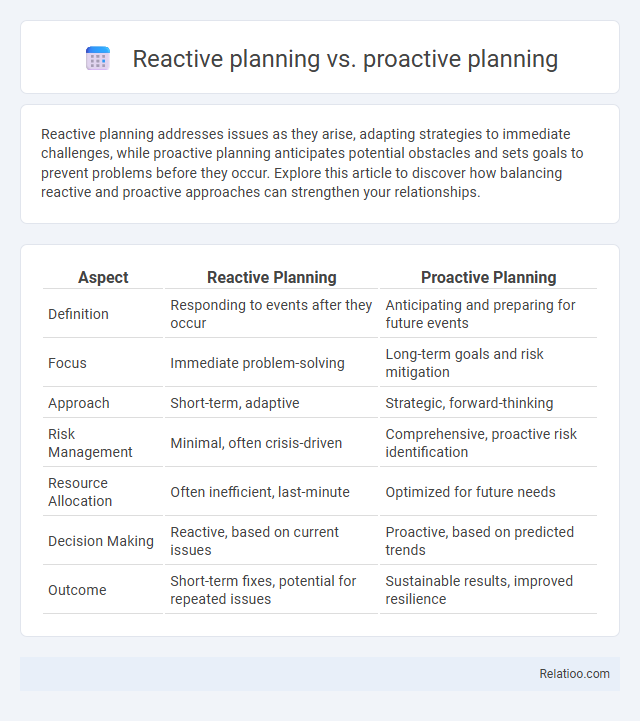Reactive planning addresses issues as they arise, adapting strategies to immediate challenges, while proactive planning anticipates potential obstacles and sets goals to prevent problems before they occur. Explore this article to discover how balancing reactive and proactive approaches can strengthen your relationships.
Table of Comparison
| Aspect | Reactive Planning | Proactive Planning |
|---|---|---|
| Definition | Responding to events after they occur | Anticipating and preparing for future events |
| Focus | Immediate problem-solving | Long-term goals and risk mitigation |
| Approach | Short-term, adaptive | Strategic, forward-thinking |
| Risk Management | Minimal, often crisis-driven | Comprehensive, proactive risk identification |
| Resource Allocation | Often inefficient, last-minute | Optimized for future needs |
| Decision Making | Reactive, based on current issues | Proactive, based on predicted trends |
| Outcome | Short-term fixes, potential for repeated issues | Sustainable results, improved resilience |
Understanding Reactive Planning: Definition and Key Elements
Reactive planning involves responding to events or changes as they occur, emphasizing flexibility and quick decision-making to address immediate challenges. Key elements include real-time problem-solving, adaptability to unforeseen circumstances, and short-term focus to mitigate risks or capitalize on sudden opportunities. This approach contrasts with proactive planning's anticipatory strategies and long-term vision's strategic foresight, highlighting its role in dynamic and uncertain environments.
What is Proactive Planning? Core Concepts Explained
Proactive planning involves anticipating future challenges and opportunities to formulate strategies that prevent issues before they arise, ensuring smoother project execution and risk management. Unlike reactive planning, which responds to problems after they occur, proactive planning emphasizes foresight, preparation, and continuous monitoring to adapt plans dynamically. Your ability to implement proactive planning enhances decision-making effectiveness and aligns short-term actions with your organization's long-term vision for sustained success.
Key Differences Between Reactive and Proactive Planning
Reactive planning centers on responding to immediate challenges or changes as they arise, making it adaptive but often short-term focused. Proactive planning anticipates future opportunities and risks, enabling you to implement strategies that prevent problems and capitalize on trends ahead of time. Long-term vision integrates both approaches by setting broad, strategic goals that guide decision-making and ensure sustained growth over extended periods.
Advantages of Reactive Planning in Unpredictable Environments
Reactive planning excels in unpredictable environments by allowing rapid adaptation to sudden changes and unexpected events, ensuring immediate problem-solving and minimizing downtime. It leverages real-time data and feedback to optimize responses, enhancing flexibility and operational resilience. This agility helps organizations maintain performance levels despite fluctuating conditions and uncertainties.
Benefits of Proactive Planning for Long-term Success
Proactive planning enables you to anticipate challenges and allocate resources effectively, ensuring consistent progress toward long-term goals. It fosters adaptability by preparing for potential risks and market changes, reducing disruptions and maximizing opportunities. This strategic foresight enhances organizational resilience and drives sustainable success over time.
Common Situations Where Reactive Planning Excels
Reactive planning excels in dynamic environments where immediate response to unexpected changes is crucial, such as emergency management, customer service issues, and agile software development. Your ability to quickly adapt to real-time information helps minimize risks and capitalize on unforeseen opportunities. Unlike long-term vision and proactive planning, reactive planning thrives when flexibility and rapid problem-solving become priorities.
When to Choose Proactive Planning: Ideal Scenarios
Proactive planning is ideal when you anticipate upcoming challenges or opportunities and want to stay ahead of potential disruptions, such as market shifts or technological advancements. You should choose proactive planning if your organization operates in a rapidly changing environment where early action can provide a competitive advantage or prevent costly crises. Incorporating your long-term vision ensures that proactive steps align with strategic goals while blending reactive planning helps you adapt swiftly to unforeseen events.
Challenges and Pitfalls of Reactive Planning
Reactive planning often struggles with unpredictability and short-sighted decision-making, leading to inefficient resource allocation and missed strategic opportunities. Frequent reliance on immediate responses can cause organizations to overlook underlying issues, resulting in repeated crises and operational disruptions. This approach limits the capacity for innovation and sustainable growth compared to proactive planning and long-term vision strategies.
Overcoming Obstacles in Proactive Planning Implementation
Proactive planning anticipates potential obstacles by identifying risks early and developing contingency strategies, unlike reactive planning which responds only after challenges arise. Long-term vision supports proactive planning by aligning goals with future scenarios, ensuring your organization remains adaptable and focused despite uncertainties. Overcoming obstacles in proactive planning requires continuous monitoring, stakeholder engagement, and flexibility to adjust plans before issues escalate.
Integrating Reactive and Proactive Planning for Optimal Results
Integrating reactive and proactive planning enhances organizational agility by balancing immediate responsiveness with strategic foresight, ensuring adaptability in volatile markets. Reactive planning addresses unforeseen challenges through quick, data-driven decisions, while proactive planning anticipates trends and allocates resources efficiently for future opportunities. Combining these approaches with a long-term vision aligns short-term actions with overarching goals, optimizing performance and sustainable growth.

Infographic: Reactive planning vs Proactive planning
 relatioo.com
relatioo.com